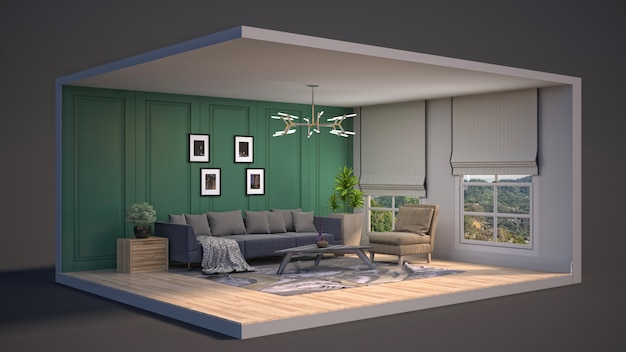In today’s digital world, 3D interior rendering services have transformed how designers create and present designs. These innovative services enable architects and interior designers to visualize spaces accurately and compellingly. The ability to produce photorealistic images helps clients to understand concepts more effectively and fosters meaningful collaboration. This article explores the significance of 3D interior rendering services, their benefits, and how they are shaping the design industry.
Understanding 3D Interior Rendering Services
3D interior rendering services involve creating realistic digital representations of interior spaces. Utilizing advanced software, designers can simulate how an interior will look based on the proposed layout, colors, and materials. With these services, clients are presented with stunning images that evoke an emotional connection to their future space. The process begins with gathering information about design preferences, dimensions, and functional requirements. Following this, designers create a 3D model that serves as the foundation for rendering.
This rendering process enables clients to grasp how the final product will look before any physical work is done. By visualizing a space, clients can make informed decisions regarding design elements. Furthermore, these services help bridge the communication gap between designers and clients, resulting in a smoother workflow.
Benefits of Using 3D Interior Rendering Services
The growing popularity of 3D interior rendering services can be attributed to the numerous benefits they offer. These advantages provide immense value for designers, clients, and stakeholders involved in interior design projects.
1. Enhanced Visualization:
3D rendering allows clients to see highly accurate representations of proposed designs, making ideas tangible.
2. Improved Communication:
Visualizations minimize misunderstandings between clients and designers, ensuring a shared understanding of the design concept.
3. Faster Approval Processes:
Clients can quickly approve designs when presented with visually appealing representations, leading to shorter project timelines.
4. Cost-Effective Decision Making:
By visualizing the space, clients can identify potential issues or needed changes before construction begins.
5. Marketing Opportunities:
3D renderings can be used in marketing materials, enhancing the presentation of design portfolios. These benefits contribute significantly to the effectiveness and efficiency of the design process.
The 3D Rendering Process
The creation of a 3D interior rendering involves several key steps, each contributing to the final product’s quality. Understanding this process is essential for both designers and clients.
1. Information Gathering:
The process starts with collecting all necessary information, including architectural plans and client preferences.
2. 3D Modeling:
Designers create a digital model of the intended space using specialized software, laying the groundwork for visualization.
3. Texturing and Materials:
Realistic textures and materials are applied to the model, mimicking various surfaces like wood, metal, and fabric.
4. Lighting Setup:
Lighting plays a critical role in creating ambiance; therefore, designers add appropriate light sources to enhance the environment.
5. Rendering:
Once the model is prepared, the final rendering transforms it into a photorealistic image or animation.
6. Client Feedback and Revisions:
After presenting the renderings, designers incorporate client feedback, refining the design to ensure satisfaction.
This methodical approach enables designers to produce high-quality visuals that meet client expectations.
Applications of 3D Interior Rendering Services
3D interior rendering services have a wide range of applications in various sectors, showcasing their versatility. These services are essential in both residential and commercial projects, helping visualize and communicate design ideas effectively.
1. Residential Design:
Homeowners utilize interior rendering services to envision spaces, from living rooms to kitchens.
2. Commercial Projects:
Businesses benefit from 3D renderings to visualize office layouts, retail spaces, and hospitality environments.
3. Real Estate Marketing:
Real estate agents use 3D renderings to showcase properties, attracting potential buyers with stunning visuals.
4. Event Planning:
Interior rendering can assist event planners in visualizing layouts, decorations, and arrangements for various occasions.
These applications highlight the importance of 3D rendering services in numerous industries, enhancing both collaboration and creativity.
Future Trends in 3D Interior Rendering Services
As technology continues to advance, the landscape of 3D interior rendering services is evolving rapidly. Emerging trends are expected to further enhance the design and visualization process.
1. Virtual Reality (VR) and Augmented Reality (AR):
Integrating VR and AR technologies allows clients to experience designs in an immersive environment, enhancing interactivity.
2. Artificial Intelligence (AI):
AI-driven solutions can optimize the rendering process, providing faster results while improving accuracy and detail.
3. Cloud-Based Rendering:
This technology allows designers to utilize powerful remote servers, reducing rendering time and costs significantly.
4. Real-Time Rendering:
Real-time rendering enables designers and clients to see design changes instantly, fostering instant feedback and collaboration.
As these trends unfold, they promise to revolutionize how designers approach interior rendering, making it more efficient and accessible.
Conclusion
In conclusion, 3D interior rendering services have considerably transformed the design industry, providing designers and clients with unprecedented visualization capabilities. These services enhance communication, improve decision-making, and foster collaboration throughout the design process. As technology continues to advance, the future of 3D rendering looks promising, introducing innovative trends that will further elevate client experiences. Investing in 3D interior rendering services not only enriches design processes but also brings visions to life in spectacular fashion.

